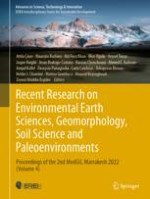2024 | Buch
Recent Research on Environmental Earth Sciences, Geomorphology, Soil Science and Paleoenvironments
Proceedings of the 2nd MedGU, Marrakesh 2022 (Volume 4)
herausgegeben von: Attila Çiner, Maurizio Barbieri, Md Firoz Khan, Ilker Ugulu, Veysel Turan, Jasper Knight, Jesús Rodrigo-Comino, Haroun Chenchouni, Ahmed E. Radwan, Amjad Kallel, Dionysia Panagoulia, Carla Candeias, Arkoprovo Biswas, Helder I. Chaminé, Matteo Gentilucci, Mourad Bezzeghoud, Zeynal Abiddin Ergüler
Verlag: Springer Nature Switzerland
Buchreihe : Advances in Science, Technology & Innovation
